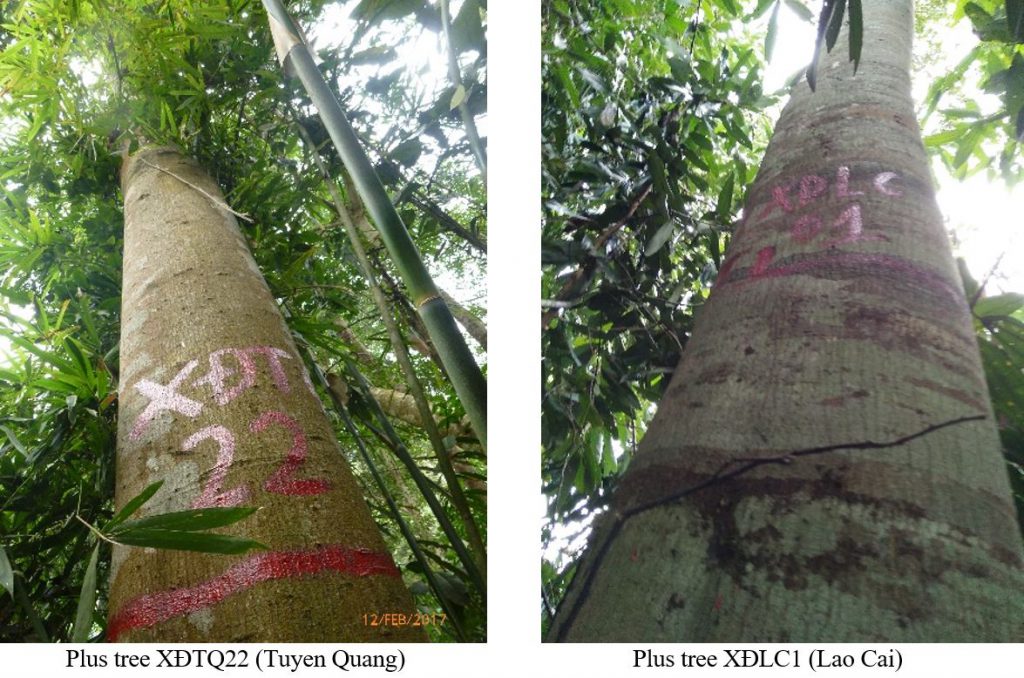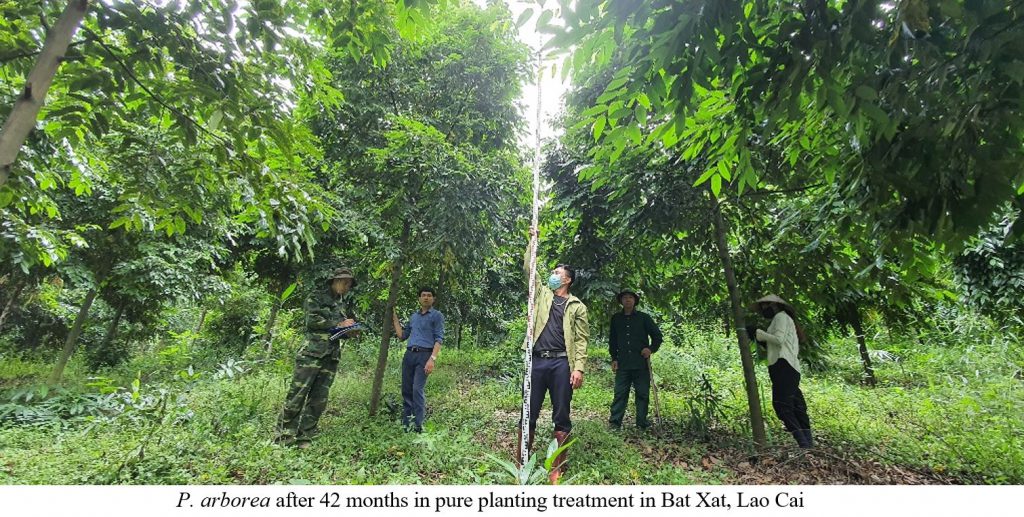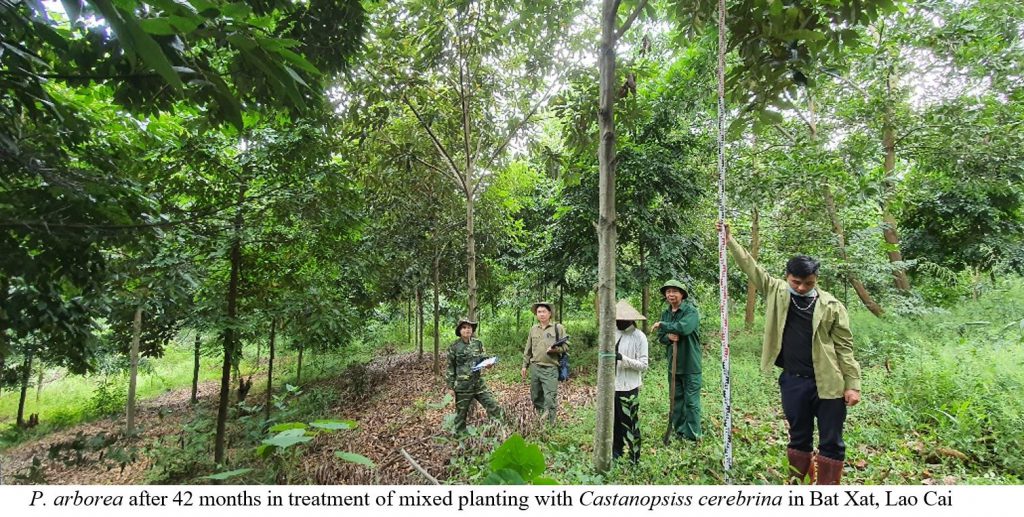Project leader: Dr. Hoang Van Thang
Lead implementing institution: Vietnamese Academy of Forest Sciences
Funding agency: Ministry of Agriculture and Rural Development of Vietnam
Implementation period: five years, from 1/2017 to 12/2021
Objectives of the study: (i) To select at least 100 plus trees of P. arborea, at least two provenances and five promising families of P. arborea per region; (ii) To establish 6 ha of provenance testing models and 10 ha of experimental model of intensive afforestation experiments with P. arborea. (iii) To develop technical guidances on propagation and intensive afforestation of P. arborea for providing lager timber.
Research content and methods: The project was implemented four research contents including (1) Study on some silvicultural characteristics of P. arborea, (2) Selection of varieties, propagation and testing of varieties of P. arborea, (3) Research on intensive afforestation techniques of P. arborea for providing lager timber, (4) Development of technical guidances for propagation and intensive afforestation of P. arborea for providing large timber.
The study used the method of representing standard plots in the natural forest states to study the silvicultural characteristics of P. arborea; conducted scoring based on the criteria of growth and stem quality to evaluate and select the plus trees in the natural forest according to six different provenaces representing the Northwest and Northeast regions; set up testing of varieties for 55 families of six provenances in complete block design with eight replicates, each replicate had four trees per family with stocking at planting of 625 trees ha-1 (4 m × 4 m) and planting time in 2019. Simultaneously, the experiments were designed as randomized complete blocks with three replicates for implementing the contents of propagation in Ha Noi and the experiments of intensive afforestation (density, fertilization and mode of planting) of P. arborea in Lao Cai and Bac Giang provinces in 2018. Using methods of analysis of variance, comparing samples through mathematical statistics in forestry to analyze and process data by Excel and SPSS software.
Key results:
+ Silvicultural characteristics: P. arborea is naturally distributed in many forest states, from IIA, IIB, to IIIA1, IIIA2 and IIIA3, on medium to very acidic soils with pH<4 and mechanical composition including sandy, light loam, heavy clay and medium clay soils. The average density of mature P. arborea spcecies in natural forest states was ranged from 5 to 56 trees ha-1 (average is 26 trees ha-1). The rate of average percentage of P. arborea in the stands was 3.6%. In the natural forest states in the four surveyed provinces, P. arborea was ecologically significant in the states with the IVI index ranged from 6.1% to 7.8%. P. arborea was participated in the formula of regenerating trees varied from 5.56% to 6.12%. P. arborea had a positive interaction at a moderate or higher level with the species of Canarium album, Canarium tramdenum, Castanopsis ducampii, Castanopsis indica, Castanopsis cerebrina, Choerospondias axillaris, Schima walichi, Endospermum chinense, Machilus thunbergii, Dipterocapus retusus, Cinnamomum cassia, Styrax tonkinensis, Madhuca pasquieri, Cinadenia paniculata, Cinnamomun obtusifolium, mangglietia conifera, Ailanthus triphysa and Walsura elata.
+ Propagation techniques: seeds should be treated by soaking in warm water at temperature ranged from 40oC to50ºC for six hours; using potting medium of 93% topsoil and 7% Song Gianh microbial organic fertilizer; Select seedlings with two cotyledons for transplanting into pots and spray Mancozeb 80 WP insecticides (5 g 1 liter-1 of water for 2 m2) to prevent fungal diseases for P. arborea seedlings in the nursery stage. The project has developed a technical process for propagating P. arborea by seeds and has been recognized by the Ministry of Agriculture and Rural Development as a new Technical Progress, and has been granted a Patented useful Solutions by the National Office of Intellectual Property.
+ Selection of P. arborea varieties: The study selected 108 plus trees of P. arborea of six provences including 23 trees in Hoa Binh, 14 trees in Son La, 21 trees in Lao Cai, 18 trees in Tuyen Quang, 14 trees in Phu Tho and 18 trees in Bac Giang. The plus trees in Lao Cai have been recognized the orginal varieties resources by the Department of Agriculture and Rural Development. After age 27-31 months, the varieties testing trials in two regions had the survival rate of families from 56.3% to 87.5%. Initially, three promising provenaces were identified including Lao Cai, Tuyen Quang and Bac Giang. The Lao Cai provenace was the most promising in both regions and was granted the New Plant Variety Protection Certificate VAFS-XĐ.HT by the Department of Crop Production. In Lao Cai province, the five most promising families of Lao Cai and Tuyen Quang provenaces were identified, and in Bac Giang province, the nine most promising families were selected from Bac Giang, Lao Cai and Tuyen Quang provenaces. These prospective families had stem volume higher by ranged form 55.6% to 120.7% compared to the average of population.
+ Intensive afforestation technique of P. arborea: When measured at age 41-42 months in two regions, it was shown that the P. arborea grown in the fertilizer experiments had a relatively high survival rate, reaching from 80 to 89.2%. The fertiliser experiment with a higher amount than the amount of fertilizer determined according to the needs of the tree showed the best growth of P. arborea with D1.3 ranged form 6.6cm to 7.6 cm, Hvn ranged from 6.1 m to 6.2 m, Dt varied from 3.6 m to 3.7 m and stand volume ranged form 5.7 m3 ha-1 to 7.8 m3 ha-1. At age 32-42 months after planting, the planting mode was different between the experiments. Treatments of mixed planting of P. arborea with Castanopsiss cerebrina and pure planting of P. arborea plantaion were in the group for the best growth of P. arborea with D1.3 ranged from 6.8 cm to 8.7 cm, Hvn ranged form 6.0 m to7.2 m. At age 32 months, there were no differences in the growth parameters in the density experiments of P. arborea in both sites. Compared with the production plantation models of P. arborea, the intensive cultivation of P. arborea in the best experment of the study had an excess of stem volume from 79.5% to 252.6%. From the research results, the project has developed the technical guidances on propagation and intensive afforestation of P. arborea for providing lager timber and has been granted a Patented useful Solutions by the National Office of Intellectual Property.
Latest news
- Project: "Research on improving the economic efficiency of plantation timber value chains, meeting legal timber requirements and sustainable forest management"
- Project: Commercial-scale yield trial and completion of planting techniques for newly recognized acacia hybrid cultivars (BV586, BV376, BB055, BV584, BV523, BV434, BV350)
- Project: Study on technology of producing hollow veneer-based composite used in construction and interior wooden furniture
- VFCS is published on the website of the Forestry Department, Ministry of Agriculture, Forestry and Fisheries of Japan
- Memorandum of Understanding signing ceremony on handing over new wood material samples from the Finnish Embassy to the VAFS for displaying
Oldest news
- Project: "Research on cultivar selection and silvicultural techniques of Huynh (Tarrietia javanica Blume) intensive reforestation for supplying large timber in the Northern and Southern Central regions"
- Project: Breeding and planting method development of Chukrasia tabularis for high productivity and tolerance of shoot-tip borer in Vietnam.
- Vietnam Journal of Forest Science Number 5-2022
- Special Issue Number 2022
- The Annual Steering Committee Meeting in 2022 of the AFoCO Project: Improving Pinus caribaea Morelet for Plantation on Degraded Land in Viet Nam’s Northern Mountainous Region










